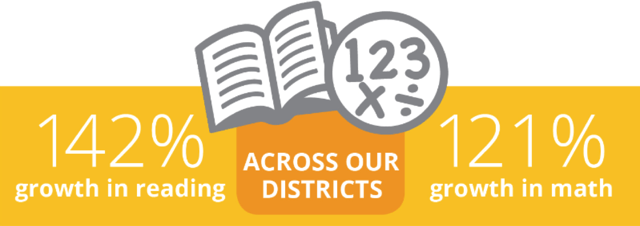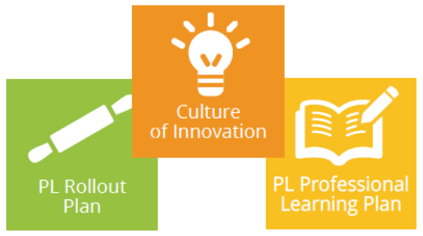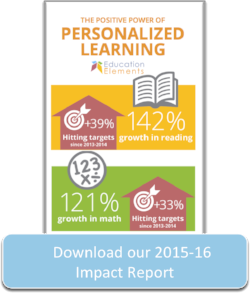Last week, we released our third annual Impact Report, “The Positive Power of Personalized Learning.” In the report, we share the incredible work and positive outcomes of districts we work with across the nation, from those that are just launching personalized learning to those that are embarking on their fourth year of implementation.
Since this is our third year sharing this report, I want to share three key takeaways from what we’re seeing (and celebrating) in the field. Still, this is just a peek; you’ll have to download the report to learn more.
1. Personalized learning works. It increases engagement and improves student outcomes.
We’ve been saying this, and we will keep saying it, because the proof is in the numbers -- year after year after year.
Students in personalized learning classrooms consistently grow more than national benchmarks in reading and math:
- This past year, an analysis of 17,000 students in districts that worked with us showed 142% growth in reading and 121% growth in math on the NWEA MAP exam, compared to national norms.
Districts going into years three and four of their implementation have seen student growth increase each year:
- The Enlarged City School District of Middletown (NY) just completed their third year of personalized learning. Compared to their first year of personalized learning in SY 2013-2014, Middletown has seen 33% more students achieve their growth targets in reading and a 39% more in math.
The qualitative results we see align with the quantitative. District leaders, school leaders, and teachers agree that their students are more engaged and self-directed since the implementation of personalized learning; teachers feel more effective and report that they are able to provide more differentiated instruction.
- We surveyed 168 school and district leaders across 11 districts: 85% of district leaders said that students are more engaged in class and 75% of school leaders said that students are taking more ownership of their learning since implementing personalized learning.

2. Every quality implementation of personalized learning is different -- and that’s how it should be.
For personalized learning to be successful, everyone from the superintendent’s office to the classroom must be aligned on the vision and purpose, teachers must have support, and change must be sustainable.
But just as personalized learning means a unique learning path for every student, making the shift to personalized learning requires a unique implementation for every district - there is no one right way to make this happen. At Education Elements, we approach our work with each district with the mindset that, while we can share what has worked elsewhere, we must seek to understand the distinct culture and context of each district and school.
Our Personalized Learning Implementation Framework provides a structure for districts to think through when planning their own rollout, but it is not a set of rigid instructions. Our districts approach each area of the framework differently according to their organizational and student needs.
For example, take these three districts who employed different strategies to successfully roll-out personalized learning:
- Yuma Elementary School District One (AZ) went ‘all in’ and all 17 elementary and middle schools designed and implemented personalized learning models in their first year.
- Uinta County School District 1 (WY) finished their second year of an opt-in model that allowed their teachers to choose to transition to blended learning over several years.
- Five schools at Racine Unified School District (WI) identified a subset of teachers as personalized learning “champions” that piloted personalized learning instructional models this spring semester.
Or, check out how these districts approached the challenges of improving communication around personalized learning and creating a culture of innovation:
- Metropolitan School District of Warren Township (IN) district and school teams used social media to quickly share new ideas and instructional models using the hashtag #warrenbl.
- Teachers in Hartford Public Schools (CT) participated in a "Design Showcase Showdown" during which they shared personalized learning instructional strategies that are working for them.

3. There is much more to do.
We are so proud of the work that our districts have accomplished, but our motto is “Learners of today. Ready for tomorrow.” As such, we are always looking ahead. Education Elements is committed to leading this transformation with districts across the country.
Though schools in every state are introducing digital devices and online content to their classrooms, they are still working out how to leverage technology to create authentically student-centered personalized learning environments. As our board member and co-founder of the Christensen Institute Michael Horn asked in a recent blog post, “Are we going to transform our education system into a student-centered one or merely digitize the existing one?”
Implementing high-quality personalized learning involves much more than device deployment; it requires a district-wide vision, design thinking, change management, and alignment at every level, from the classroom to the boardroom. Plus, districts can’t do this work alone. They need to share their innovations, their successes, and even their failures with each other.
As we look to the future, we are confident that the momentum behind this national conversation will only grow. We look forward to continuing to work side-by-side with our districts in 2016-17 to design and implement high quality personalized learning and, in the process, transform our education system and better prepare every student for their future.






